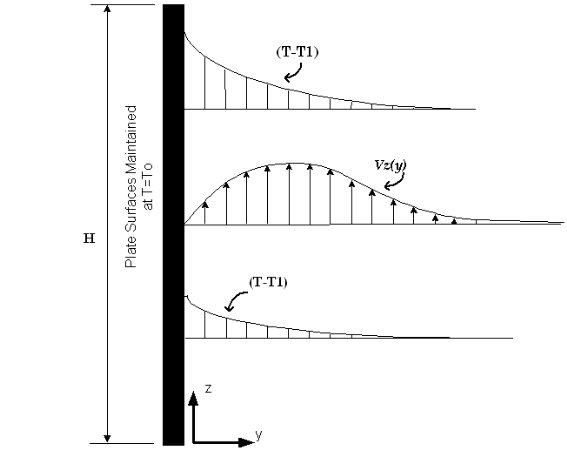

Example 10.5-4. FREE CONVECTION HEAT TRANSFER FROM A VERTICAL PLATE
Start with the basic continuity equation found in Table 3.4-1 (A), the motion equation
from table 10.4-2 (C), and the energy equation from table 10.4-2 (E). The equations are simplified
by dropping the x component of v, the transient terms and any other dependence on x.
Only the z component of motion is needed for this analysis.
> restart;
> eqcont:=diff(vy(y,z),y)+diff(vz(y,z),z)=0;
![]()
> eqmot:=rho*(vy(y,z)*diff(vz(y,z),y)+vz(y,z)*diff(vz(y,z),z))=mu*diff(vz(y,z),y,y)+rho*g*beta*(T(y,z)-T1);
![]()
![[Maple Math]](images/problem3.gif)
> eqeng:=rho*Cp*(vy(y,z)*diff(T(y,z),y)+vz(y,z)*diff(T(y,z),z))=k*diff(T(y,z),y,y);
![[Maple Math]](images/problem4.gif)
Now subsitute in the dimensionless variables (Equations 10.5-39-43)
> with(PDEtools,dchange);
![]()
> trans:={T=T1+Theta*(T0-T1),z=zeta*H, y=eta*(mu*alpha*H/B)^(1/4), vz=phiz*(B*alpha*H/mu)^(1/2), vy=phiy*(alpha^3*B/(mu*H))^(1/4)};
![]()
![[Maple Math]](images/problem7.gif)
Next, we will only need to use four of the transformations in trans. In fact, Maple will object if we try to use them all. We'll select those four but we need to see where Maple put them in trans. Maple may not store the elements in a set in the same order you give them.
> trans[2..5];
![[Maple Math]](images/problem8.gif)
> newcont:=dchange(trans[2..5], eqcont, [eta,zeta,phiy(eta,zeta), phiz(eta,zeta)]);
![[Maple Math]](images/problem9.gif)
> eq1:=simplify(%,assume=positive); This is equation 10.5-44
![[Maple Math]](images/problem10.gif)
> newmot:=dchange(trans, eqmot, [eta,zeta,phiy(eta,zeta),phiz(eta,zeta),Theta(eta,zeta)]);
![[Maple Math]](images/problem11.gif)
![[Maple Math]](images/problem12.gif)
> simplify(%,assume=positive);
![[Maple Math]](images/problem13.gif)
![[Maple Math]](images/problem14.gif)
> k:=alpha*rho*Cp;beta:=B/(rho*g*(T0-T1));mu:=Pr*k/Cp;
![]()
![]()
![]()
> eq2:=simplify(newmot/B,assume=positive); This is equation 10.5-45
![[Maple Math]](images/problem18.gif)
> neweng:=dchange(trans, eqeng, [eta,zeta,phiy(eta,zeta),phiz(eta,zeta),Theta(eta,zeta)]);
![]()
![[Maple Math]](images/problem20.gif)
![[Maple Math]](images/problem21.gif)
> simplify(%,assume=positive);
![[Maple Math]](images/problem22.gif)
![[Maple Math]](images/problem23.gif)
> simplify(sqrt(Pr*H/(rho*B))*%/(Cp*(T0-T1)));
![[Maple Math]](images/problem24.gif)
![[Maple Math]](images/problem25.gif)
> eq3:=simplify(%,assume=positive);
>
![[Maple Math]](images/problem26.gif)
Note: the boundary conditions do not introduce any new parameters in our description of the process.
From the first line of 10.5-51:
> S:=(B/(mu*alpha*H))^(1/4);
![[Maple Math]](images/problem27.gif)
> qav:=-K*(T0-T1)*S*int(diff(Theta(eta,zeta),eta),zeta=0...1);
![[Maple Math]](images/problem28.gif)
> Nu:=simplify(qav*H/(K*(T0-T1)));
![[Maple Math]](images/problem29.gif)
> prod:=S*H;
![[Maple Math]](images/problem30.gif)
> GrPr:=rho*H^3*B/mu^2*Pr;
![[Maple Math]](images/problem31.gif)
Now we can show that S*H is the same as (GrPr)^(1/4) for equation 10.5-51
> prod-(GrPr)^(1/4);
>
![[Maple Math]](images/problem32.gif)
> simplify(%,assume=positive);
![]()
Yay! It was correct!
> Nu/(GrPr^(1/4));
![[Maple Math]](images/problem34.gif)
> simplify(%,assume=positive);
![[Maple Math]](images/problem35.gif)
This is the integral in equation 10.5-51 with the dervative evaluated at eta=0. It is the only other part of the solution , when solved, corresponds to 'C' in equation 10.5-51. It can only be a function of Pr.
>
